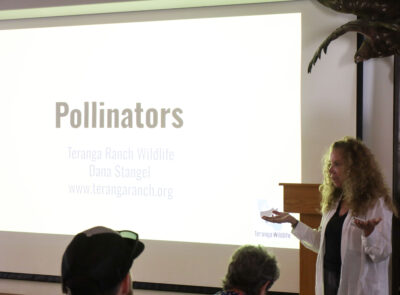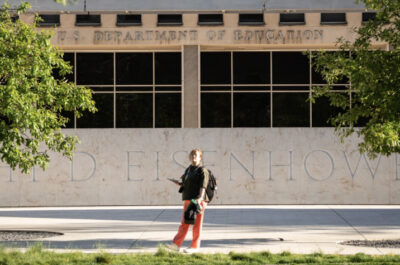Legal counsel for state air regulators once again accused Chiquita Canyon Landfill officials of distorting the picture of the facility’s subsurface reaction Wednesday, during another hearing over a more than 18-month-old abatement order.
Problems at the landfill, which have plagued the Castaic and Val Verde communities for more than two years, were the impetus behind this week’s meeting of the South Coast Hearing Board for the Air Quality Management District.
Under federal and state law, the South Coast Air Quality Management District is under a legal obligation to enforce air pollution regulations, according to its website.
Kathryn Roberts, senior deputy district counsel for the South Coast AQMD, said the reaction is spreading eastward across the northern portion of the landfill, and the landfill is paying consultants to present whatever data it can to dispute that.
“And you’ll also hear as a consistent theme today in evidence across multiple witnesses, that Chiquita has a predetermined conclusion about the state of this landfill, and then it works to fit its pre-existing conclusion,” Roberts said in her opening comments at the livestreamed hearing in Diamond Bar. “When the data doesn’t fit, Chiquita works to obscure and, in some cases, even ignore the relevant data. The result from Chiquita is a distorted picture of the state of this reaction.”
Lawyers for Chiquita Canyon were contesting two conditions proposed by the district, which it said will impact its existing abatement orders.
“We urge the board not to order measures that will frustrate landfill gas-extraction efforts and will ultimately result in more harm to the community surrounding Chiquita,” said Megan Morgan of Beveridge & Diamond, attorney for Waste Connections, which operates Chiquita.
Morgan was arguing against an order for automated well-head controls intended to improve methane detection in air quality. She said the machines discount the ability of the landfill’s experts to manage the reaction.
“Chiquita and the community cannot take the risk the system will impede its extraction of gas or liquids from the landfill, as you’ll hear from Chiquita’s witnesses,” Morgan said. “Chiquita’s mitigation measures are working as intended, and these efforts should not be forestalled simply because the district wants to eliminate every judgment call that could be made at the landfill.”
Roberts argued that the opposite was true regarding the mitigation measures.
Chiquita Canyon officials cut off their financial support to relocate residents impacted by the landfill over two months ago, saying there’s been significant improvement at the reaction area. Waste Connections has pointed those asking for evidence to the reports on its website, some of which are hundreds of pages long.
In her opening argument, Roberts said the landfill’s presentation of its air data in those reports is an instance where the numbers reported are intended to fit the “predetermined” narrative. Important information is reported in an intentionally vague manner, Roberts said.
“For example, Chiquita’s own consultants have set 2,000 parts per billion as an indicator threshold for carbon monoxide levels, as an indicator of where the reaction might be,” she said.
While they are required to produce graphs that show where the reaction area might be growing, “they produce them in ranges that only show between 1,000 and 1 million (parts),” she said.
By creating a range so broad, “You would have no way to tell which of these little pink wells are actually showing an indication of the reaction,” she said.
She said it’s not an isolated incident, and oxygen levels are presented the same way on a graph for Wednesday’s hearing that shows two oxygen levels on one chart: 0% to 2% and 2% to 100%.
Roberts said through the course of the two-day hearing, the board would hear from Todd Thalhamer, the senior waste management engineer for CalRecycle, the state agency that oversees landfills, who will explain the need for the modified abatement orders and increase in mandated testing.
The second order being contested by Chiquita had to do with requirements for more air monitoring using aerial surveillance, which is already partially in use at the landfill.
“As you will hear from the district witnesses, the reaction is — you will likely hear from the district witnesses, that the reaction is expanding and that, as a result, these contested conditions are necessary,” Morgan said.
“Chiquita adamantly disputes these allegations,” she said. “Chiquita’s witnesses have spent years studying this facility. They will describe that conditions on site are vastly different than from when the reaction was first identified.”
Castaic and Val Verde residents once again opened the hearing by testifying about the health problems they’ve blamed on the ongoing environmental crisis at Chiquita Canyon Landfill.
The range of health problems blamed on the landfill once again ranged from headaches and eye irritation to claims of cancer clusters being studied by L.A. County Public Health.
Both sides pointed to data as part of their case.
Chiquita pointed to 97 substantive conditions in a 100-page stipulated order it’s been following, which includes the installation of 292 gas extraction wells, including 13 in 2025, reaching depths of up to 200 feet.
The landfill has been under an abatement order since September 2023, and that’s not the first time, said Roberts, who added the problems this time are “orders of magnitude” worse than the last time the facility was under abatement orders due to odors from 2020 to 2022.
In response to the landfill’s claims the situation has gotten better for residents, Roberts said there were 11 notices of violation issued in May, the highest single-month total for the year. Since 2023, the landfill is approaching 30,000 complaints, she added.
The board is expected to resume the hearing at 9:30 a.m. June 17. The meeting will be held in Diamond Bar and virtually with information available here on the AQMD website: bit.ly/43JnkYD.








